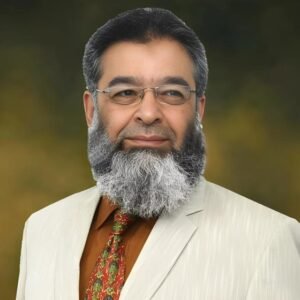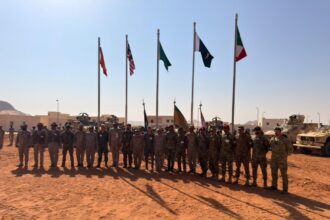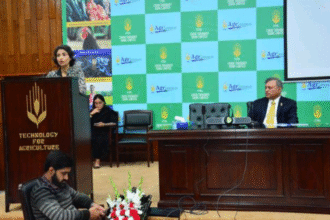
by Muhammad Mohsin Iqbal
The history of mankind is, in no small measure, a history of conflict and conquest. From the dawn of human existence, when survival depended upon the hunt and protection from rival tribes, the creation and refinement of weaponry has marched in lockstep with the evolution of civilizations. What began as a crude wooden spear—such as those uncovered in Germany and dating back nearly 400,000 years—gradually transformed into instruments of ever greater precision, lethality, and political consequence.
As the tides of history turned and man mastered the elements, so too did his weapons evolve. The Iron Age, commencing around 1200 BCE, introduced the hardened blades and steel-forged tools that defined the military prowess of ancient empires—the Assyrians, with their chariots and swords, and the Celts, known for their formidable metalwork, stand as enduring symbols of that era. With these instruments, wars were waged not only for defence, but for dominion.
Yet it was in the East, in ninth-century China, that the next revolution occurred—gunpowder. First used in ceremonial pyrotechnics, it did not take long for its martial applications to be discovered. By the fourteenth century, the knowledge of gunpowder had reached Europe, ushering in the age of muskets, cannons, and artillery. The battlefield was transformed, as was the notion of distance and destruction. War was no longer the intimate affair of blades and shields—it had become a mechanised, impersonal force.
The culmination of this technological arc came in the twentieth century, amid the fires of the Second World War. It was then that science, ambition, and fear converged to produce the most devastating weapon yet conceived by man—the atomic bomb. The United States, under the secretive Manhattan Project, succeeded in detonating the world’s first nuclear device on July 16, 1945, in the deserts of New Mexico. That experiment, codenamed “Trinity,” would soon be followed by the infamous bombings of Hiroshima and Nagasaki. The cities were obliterated, hundreds of thousands perished, and the world beheld for the first time the terrifying potential of nuclear force.
The war ended, but a new and perilous era began—the Cold War. The Soviet Union, not to be outpaced, conducted its first nuclear test, “RDS-1,” on August 29, 1949, in the steppes of Kazakhstan. Thus began the arms race between the two superpowers, each viewing the other not merely as a rival, but as an existential threat. The balance of terror, precarious yet effective, shaped international politics for decades.
Other nations, too, followed suit. The United Kingdom tested its first nuclear weapon in 1952, not in its homeland but on the remote coast of Australia. France, asserting its independence in the wake of the Suez Crisis, conducted its inaugural test in Algeria in 1960. China, isolated and hemmed in by both the Soviet Union and the United States, demonstrated its capability in 1964 at Lop Nur. Each of these powers justified their actions in the name of security, sovereignty, or strategic parity.
India joined the nuclear club in 1974 with its so-called “peaceful nuclear explosion”—the Smiling Buddha test. However, by 1998, any pretense of peaceful intent was cast aside with a series of underground tests that clearly indicated full weaponization. Pakistan, under intense internal pressure and geopolitical uncertainty, responded swiftly and decisively. On May 28, 1998, in the Chagai hills of Balochistan, Pakistan conducted its own nuclear tests—marking its entrance into the exclusive group of declared nuclear powers.
Pakistan’s action was not one of provocation, but of necessity. It was a message of deterrence, not aggression. As the only Islamic country to formally declare and demonstrate nuclear capability, Pakistan did so with solemn responsibility, mindful of the regional balance of power and its own right to self-preservation.
Other nations took divergent paths. North Korea, defiant and isolated, conducted its first test in 2006 and has since used its arsenal as a tool of diplomatic leverage. Israel, on the other hand, maintains a policy of deliberate ambiguity, refusing to confirm or deny its possession of nuclear weapons, though it is widely accepted that it has been a nuclear power since the late 20th century.
What remains deeply troubling, however, is the inconsistency with which the world responds to nuclear aspirations. No state, once having crossed the nuclear threshold, has been forcibly disarmed. Some have been sanctioned, others diplomatically coaxed, but all have retained their arsenals. Except, it seems, when it comes to Iran.
Unlike Israel, India, or even North Korea, Iran is a signatory to the Non-Proliferation Treaty (NPT), and has repeatedly declared that its nuclear ambitions are peaceful in nature. Yet it has faced years of economic strangulation, cyber-sabotage, diplomatic isolation, and open threats of military action. The Western world, particularly the United States and its allies, has treated Iran’s nuclear programme not with the tools of diplomacy and parity, but with suspicion and hostility.
Herein lies the contradiction that undermines the very architecture of international law and equity. Why India’s pursuit accepted, and Israel’s secrecy respected—yet Iran is singled out for punitive treatment?
This glaring double standard is not only unjust but dangerous. It signals to the world that power, not principle, governs the nuclear order. That alliances, not adherence, determine legitimacy.
In the final analysis, it is not the possession of nuclear weapons that defines responsibility, but the manner in which a state conducts itself. Pakistan has demonstrated restraint, responsibility, and rationality. It has not brandished its nuclear capability for coercion, nor has it used it to threaten regional stability. It seeks only to protect its sovereignty—no more, no less.
History may one day judge not only those who built the bomb, but those who imposed the rules of who may hold it. Until the world applies its standards with fairness, the dream of a just and peaceful international order shall remain, like the mushroom cloud itself, a shadow over the conscience of mankind.





